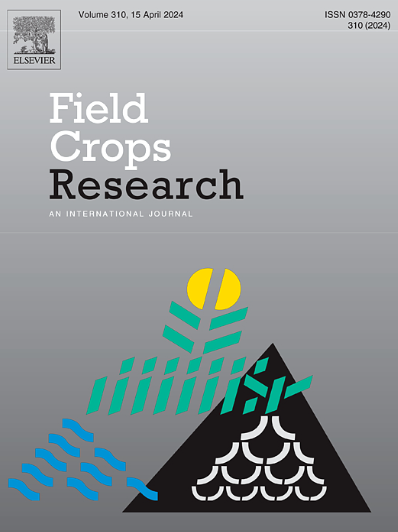Breeding for high maize yields indirectly boosting root carbon in the US Corn Belt since the 1980s
IF 5.6
1区 农林科学
Q1 AGRONOMY
引用次数: 0
Abstract
Context
Understanding changes in below-ground plant traits due to crop improvement is crucial for crop productivity and sustainability assessments.
Objectives
To quantify historical changes in root traits due to maize breeding and plant density increases and assess factors influencing root trait expression under field conditions.
Methods
We studied root mass, root length, specific root length (SRL), root: shoot ratio, and root carbon concentration in 11 maize hybrids released from 1983 to 2017 under current (8.7 plants m−2) and a historic plant density treatments (4.7, 6.2 and 8.7 plants m−2). Soil cores were collected from seven US Midwest environments.
Results
Root mass linearly increased with the years of hybrid release under current (7.6 kg ha−1 year−1, p = 0.15) and historical (18.2 kg ha−1 year−1, p = 0.0028) plant density treatments. Breeding accounted for 44 % and plant density for 57 % of the increase in root mass. Root mass significantly correlated with root carbon (r = 0.99) and grain yield (r = 0.82). Root mass genetic gain was 9-fold lower than that of grain yield. Root length remained unchanged with the year of hybrid release under current density but increased with the year of hybrid release when historical increases in plant density were imposed (0.065 km m−2 year−1, p = 0.095). Specific root length decreased with the year of hybrid release by −0.62 mm mg−1 year−1 (p = 0.0017) in both plant density treatments. The root: shoot ratio did not change with breeding or plant density. The environment substantially influenced the expression of root traits, with precipitation explaining a portion of the variability.
Conclusion
Maize breeding and historical increases in plant density increased root mass, decreased SRL, and maintained the root: shoot ratio unchanged, indicating that crop improvement has altered below-ground maize traits in different directions.
Implication or significance
Present findings enhance our understanding of how below-ground root traits have changed due to breeding and plant density, which can also support crop modeling studies and soil carbon budgets. The increase in root mass and carbon suggests that breeding for high maize yields boosts root carbon inputs and that crop improvement aids sustainability.
求助全文
约1分钟内获得全文
求助全文
来源期刊

Field Crops Research
农林科学-农艺学
CiteScore
9.60
自引率
12.10%
发文量
307
审稿时长
46 days
期刊介绍:
Field Crops Research is an international journal publishing scientific articles on:
√ experimental and modelling research at field, farm and landscape levels
on temperate and tropical crops and cropping systems,
with a focus on crop ecology and physiology, agronomy, and plant genetics and breeding.
 求助内容:
求助内容: 应助结果提醒方式:
应助结果提醒方式:


